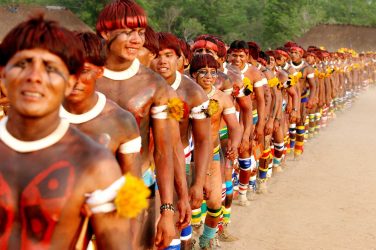 This past January (2006) I noted the sudden barrage of naked negra/mulata flesh on the Caldeirão do Huck (Huck’s Cauldron) program. Several near naked, brown skin women were introduced and given about two minutes to dance their best samba and secure votes from the audience. One couldn’t help but notice the camera’s close-up shots of naked, brown bundas (derrières) percolating at maximum tempo.
This past January (2006) I noted the sudden barrage of naked negra/mulata flesh on the Caldeirão do Huck (Huck’s Cauldron) program. Several near naked, brown skin women were introduced and given about two minutes to dance their best samba and secure votes from the audience. One couldn’t help but notice the camera’s close-up shots of naked, brown bundas (derrières) percolating at maximum tempo.
While the Caldeirão do Huck show does feature the occasional black Samba/MPB group, or game contestants, in the weeks leading up to Carnaval, viewers were exposed to more brown faces and flesh than perhaps all of the Rede Globo programs put together during the same time period.
Every year it is this brown-skinned flesh that is paraded in front of the camera during Carnaval to a global audience that attracts mass migrations of tourists anxious to participate and witness firsthand Brazil’s racially/sexually charged spectacles.
As old songs by legendary composers like Candeia and Tom Jobim have explained, the true faces of Brazil remain trapped in their poverty-ridden surroundings, exploited, degraded, murdered and excluded, waiting for this one week of ecstatic jubilance.
Thus the message is clear: for “respectable” society, the white face is prominently displayed for the majority of the year while the darker faces are invisible until it is time to attract foreign dollars through the perceived oversexed nature of the lower and darker classes.
In speaking of “lower and darker classes,” it is necessary to address these two, correlational, often confused attributes of discrimination. In the 1950s, sociologist Guerreiro Ramos stated that in Brazil, negros and o povo (common people) were synonymous. (1)
Elaborating on Ramos’s argument, Joel Rufino dos Santos explains that negro is a certain “place” that can also be occupied by non-blacks just as branco is a place that can be occupied by blacks or mulatos. (2)
In other words, while there does exist poor whites and rich blacks, the essence of the accepted associated position of both remains the same. According to dos Santos, the coordinates that fix the negro as a place are: the phenotype (crioulo), the social condition (poor), cultural heritage (popular), historic origin (African ancestry) and identity (self-definition and definition by the other). Following this line of reasoning, one concludes that “Brazilian is the better synonym of negro (black) and branco (white) a synonym of non-Brazilian.” (3)
It is with this correlation that the connection between poverty, race and police brutality become clear enough to label the alarming rates of the murder of Afro-Brazilians by police and death squads as racial genocide. Using dos Santos’s “negro as place” argument, one cannot simply use the “poor whites are discriminated against too” argument to prove a lack of racism.
Existing in a social/psychological place designated for afrodescendentes, poor whites, symbolically, are seen as black also, thus expendable. One cannot imagine death squads and violent police entering middle-upper class (overwhelmingly white) neighborhoods and killing people with the same reckless disregard in which they enter favelas. For in Brazilian history, it is the afrodescendente that elites wanted to eliminate in order to secure a whiter Brazil.
Keeping dos Santos’s argument in mind, when this Brazilian-ness vs. whiteness dichotomy appears, the middle-upper class Carioca will often times be sure to align him/herself with whiteness. For example, in John Norvell’s interview with a middle-class white Carioca, the speaker made sure to separate himself from what was perceived to be “true” Brazilian-ness.
He confirmed that “in the way that you are a foreigner here, so am I” because his name was not da Silva, he didn’t use slang all of the time, he didn’t samba, and didn’t have black blood. (4) Norvell notes that even obviously white Brazilians will often refer to themselves as moreno claro in order not to violate the Brazilian proclamation that “we’re all mixed”.
In other words, while they may not actually call themselves branco, they symbolically align themselves with attributes that are less Brazilian, or in dos Santos’s reading, closer to blackness.
Too Many Negros Equal Reverse Discrimination
This “negação do Brasil (denial of Brazil)”, as filmmaker Joel Zito Araújo puts it, is also obvious when we look at the type of fashion models Brazil promotes on the global stage. Brazilians of lower, middle and upper classes all seem to participate in the “we’re all mixed so there’s no racism” façade but where is this mixture when we look at well-known fashion models such as Gisele Bündchen, Daniella Cicarelli, Shirley Mallmann, Mariana Weickert and Ana Hickmann? Brazil’s ethnic mixture may be typical of Latin America and the Caribbean, but its runways are dominated by faces that wouldn’t be out of place in Italy or Germany.
Have other Brazilians noticed this?
Apparently, a group of black Brazilian models did. Maybe that’s why they protested against what they considered an apagão (blackout) at the famed São Paulo Fashion Week of 2001. (5) It may be true that the modeling world may be emblematic of a post-modern, narcissistic world indulged in the trivial pursuit of excess, it is also an avenue in which to address the problems that are at the heart of the Brazilian contradiction.
Perusing through various readers’ forums throughout the Internet, books and journals, I am amazed to read how many white Brazilians express shock when they see something that prominently displays images or input of black Brazilians. I frequently see comments such as:
“How racist a magazine Raça Brasil! A magazine for blacks?!?!”
“How racist! A T-shirt that says 100% negro.”
“A TV channel for blacks (TV da Gente)!! That is segregation and exclusion!!”
Actor Milton Gonçalves, director of the 1970 novela Irmãos Coragem remembers how he was accused of being racist because he tried to include black actors on the show. He experienced these same sentiments in 2004 when he participated in Joel Zito Araújo’s 2004 film Filhas do Vento, which featured a 90% black cast.
Gonçalves became indignant when a journalist asked him where the white actors were. After all, according to the journalist, with some many blacks in the production, it “ran the risk of becoming a ghetto”. An irritated Gonçalves replied that during his 50 years in the business, he always looked for black actors in white films who didn’t portray thieves, slaves or service workers. (6)
It is through comments such as these by common, middle and upper class Brazilians that I have begun to understand how racism is perceived and functions in Brazil. The nature of Brazilian racism lies in its covert operation. In Ghana, there is an old saying that says a snake that hides in the grass is more dangerous than the one in a tree, implying that it is easier to deal with something that you can see rather something you don’t know is there. (7)
On the issue of race and racism in Brazil, it appears that as long as something is implicit rather explicit it goes unnoticed. No one notices when the overwhelming majority of the people on television, magazines and magazine covers, owners of businesses and government officials are white.
As long as titles don’t explicitly say “TV da Gente Branca“, “Revista Raça Branca” or, as in the case of 1950s Brazil, “preferem-se brancos” (whites preferred), exclusion of non-whites goes unnoticed. It is only when things are entitled “Raça Negra (Black Race)” or “A Revista dos Negros Brasileiros (The magazine for black Brazilians)” that the alarm of racism is sounded.
Traditionally, Afro-Brazilians have always attempted to assimilate into mainstream Brazilian society while simultaneously trying to seduce the mainstream into celebrating facets of Afro-Brazilian culture. (8) Thus, it is mainstream (i.e. white) society that has practiced exclusionary, apartheid-style social mores but then contradictorily cry “reverse racism” when those who they have excluded create social circles, businesses or groups that look out for their own interests.
As has happened in the United States, Afro-Brazilians have taken the initiative to form their own little social networks within the larger society only when they realized that the larger society has and continues to exclude and ignore the needs of that parcel of the population that does not fit the phenotypic ideal.
Many of Brazil’s afrodescendentes remember twenty to thirty years ago when they would go into hair salons catering to a white clientele and being told “we don’t deal with that kind of hair.” (9) It is for this reason that so-called “ethnic salons” have been springing up in São Paulo, Rio, Belo Horizonte (Minas Gerais) and Salvador (Bahia). When darker faces were greatly underrepresented in the pages of mainstream magazine, Raça Brasil magazine was created.
There are millions of afrodescendentes who, like student Fabiana Oliveira, grew up hating the nose, lips and color that they saw in the mirror. Growing up in Petrópolis, Rio de Janeiro, Oliveira tried fitting in with the standard of the dominant culture but was only able to accept and like herself when she became part of the Pré-Vestibular para Negros e Carentes. (10)
When Brazil continues to value a Eurocentric standard of beauty, events like the Afro-Fashion beauty contest can be vital to the development of self-esteem and the recognition that one can be beautiful even they don’t fit the accepted standard.
Afro-Fashion was a contest created by 28-year old Roberta de Oliveira of the Sul Fluminense region of Rio de Janeiro to celebrate the beauty of the black Brazilian woman. Oliveira explained that she had to participate in many lectures dealing with the race issue to even learn to like herself:
“When I was a child I didn’t have the initiative, but I did see the same frustrations that I see in black children today. In my adolescence, I started to participate in a group from the Movimento Negro, Raízes, there I met people that really identified as being black and I started to see myself in them. There I started to construct my posture in the face of racism. (11)
As I mentioned previously, there are those who will amazingly decry these types of contests as racist. This is an issue that Oliveira has also dealt with:
“The girls ask a lot the reason for there to be a contest only for black women. I explained that the open contests already existed and there were hardly any black men and women that managed to win them. Here, in Resende, I never saw that happen. To have an idea, the guy that won the 1st Afro-Fashion, in 2001, went to participate in an open contest and he came in last place. It was then that we saw how much discrimination there was. My idea is to expose how beautiful Afro-Brazilians are.” (12)
Racism in Carnaval
Over the years, millions of tourists from around the world have flocked to Brazil to watch or participate in the country’s yearly Carnaval extravaganza. At first glance, Rio de Janeiro’s Carnaval appears to be simply an orgiastic feast of music, dance, costumes and sex in which all Brazilians participate regardless of their racial or class backgrounds.
On the outside, that appears to be true. In reality, the truth is a little more complex. It is exactly this very celebration that continually perpetuates the position of the afrodescendente as an inferior whose only value is entertainment purposes.
During the greater part of year, Brazil’s media virtually ignores its negro/negro-mestiço population until it is time to attract foreign travelers and money. While it is this time of year that the so-called mulata is celebrated for her “exotic” allure, sensuality, and mastery of the samba dance, it is also her ascribed position as mulata that marks her as “other”. Black women’s movements in Brazil have pointed out that Brazilian society has reserved two types of work for the Brazilian woman of African descent: work and sex.
Even for those who have yet to visit the country during its five-day feasts, the images and videos transmitted throughout the world are of near legendary status. While Rio remains the most famous celebration of all Brazilian major cities, the flavor of Salvador, Bahia’s Carnaval has also earned quite a reputation. In 1999, reports from Salvador highlighted a facet of this festa that was no reason for celebration.
According to reports, Venusemar Silva Andrade called the headquarters of Bloco A Barca to ask if there were still vacancies. She was told that there were. Andrade, who is black, went with two of her white friends to fill out the proper applications along with their photos and waited for approval from management.
While waiting, Andrade conversed with one of the directors of the bloco, Vicente dos Anaw6kx Filho, better known as Boko. Boko responded, “Are you crazy? Blacks don’t enter in A Barca, no. Are you trying to dirty up the bloco? This application will never be approved!” (13)
Andrade decided to press charges of racial discrimination and her case went on to set off other lawsuits and investigations by the Bahian state prosecutor’s civil rights office. High school teacher Léa Virgínia de Jesus Santiago never saw herself as being black because of her light skin, wavy hair and European features. Her view of how others saw her changed when she applied to enter the bloco Pinel e Beijo. Santiago and her six friends, all black, were refused membership into the bloco. According to Santiago:
“I’ve always suspected they discriminated. When you watch from high up in the stands, you can see that there are whole blocos without a single black face.” (14)
To test her hypothesis, Santiago applied to another bloco while a blond, white friend applied for the same bloco separately. The white friend, who didn’t need to enter a photo, was accepted in an hour while Santiago was rejected. Santiago affirmed that this incident taught her a lesson as to how racism worked in Brazil. (15)
Footnotes
1. Guerreiro Ramos, Alberto. Introdução Critica à Sociologia Brasileira. Rio de Janeiro: Andes, 1957
2. Rufino dos Santos, Joel. “O Negro como lugar”. Raça, Ciência e Sociedade. Editora Fiocruz – Centro Cultural Banco do Brasil. Rio de Janeiro, 1996.
3. Ibid
4. Norvell, John. A Brancura Desconfortável das Camadas Médias Brasileiras. Maggie, Yvonne and Rezende, C. B. (orgs.) Raça como Retórica: a construção da diferença. Rio de Janeiro, Civilização Brasileira, 2001.
5. Fernandes, Andréia and Gonçalves, Camila. “Modelos protestam contra falta de negros nos desfiles”. Redação Terra. [Available online March 22, 2006].
http://www.terra.com.br/exclusivo/spfashionweek2001/2001/07/03/003.htm
6. Fernandes, Andréia and Gonçalves, Camila. “Modelos protestam contra falta de negros nos desfiles”. Redação Terra. [Available online March 22, 2006].
http://www.terra.com.br/exclusivo/spfashionweek2001/2001/07/03/003.htm
7. Jo/Agência Anhangüera. “Onde estão os “brancos”?” [Available online April 22, 2006]. http://brasil.indymedia.org/pt/red/2004/10/292534.shtml
8. Quist-Adade, Charles. “What is ‘race’ and what is ‘racism’?” New African. April 2006. No. 450.
9. Sansone, Livio. Negritude sem etnicidade: o local e o global nas relações raciais e na produção cultural negra do Brasil. Salvador/Rio de Janeiro, Edufba/Pallas, 2003.
10. Gomes, Nilma Lino. Sem perder a raiz: Corpo e cabelo como símbolos da identidade negra. Autêntica Editora, 2006.
11. Cruz, Cíntia. “Olhar de negra”. Viva Favela website. November 15, 2006. Available online. November 16, 2006. http://www.vivafavela.com.br.
The Pré-Vestibular para Negros e Carentes is a preparatory organization that prepares Afro-Brazilians and poor people to take the standard college entrance exam.
12. Oliveira, Fabiana. “Beleza afro-fashion”. Viva Favela website. November 30, 2006. Available online. December 1, 2006. http://www.vivafavela.com.br.
13. Ibid.
14. Setti, Adriana. “Vergonha na folia”. Pontox website. Available online April 21, 2001.
http://www.pontox.com.br/marrom/clip/clipmarrom_02061999_001.htm.
Astor, Michael. “Racial democracy a myth: Carnival reveals cracks of Brazil’s racial divide”. Associated Press. Febraury 7, 2000. Available online April 21, 2001.
http://www.canoe.ca/CNEWSFeatures0002/07_brazil.html
15. Ibid.
This is part eight of a multi-piece article.
Mark Wells holds a bachelor’s degree in Anthropology from the University of Michigan-Dearborn and is currently working on a Master’s Degree in Social Justice at Marygrove College in Detroit, Michigan. He can be reached at quilombhoje72@yahoo.
© 2007 Mark Wells









